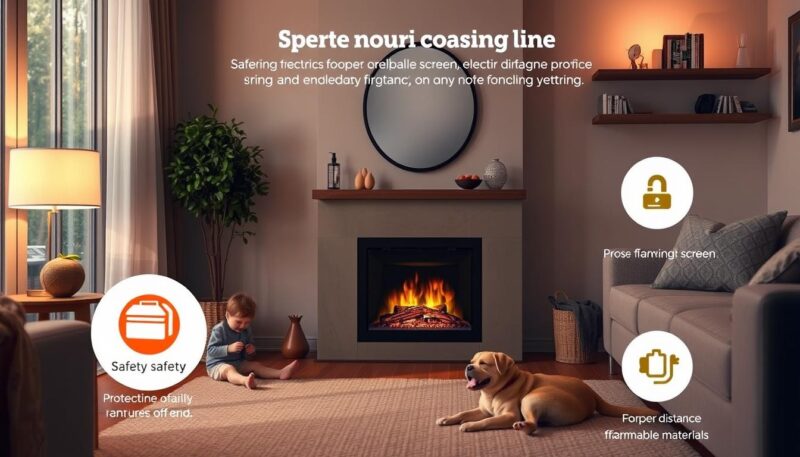Electric fireplaces offer a modern and safe alternative to traditional wood-burning or gas fireplaces. Unlike traditional options, electric fireplaces do not require real flames to generate heat, making them a safer option as they eliminate risks associated with open flames and burning embers. They do not produce harmful gases like carbon monoxide, nor do they emit smoke, making them beneficial for those with respiratory issues or allergies. Electric fireplaces are designed with built-in safety features such as overheat protection, automatic shut-offs, and cool-to-the-touch surfaces, enhancing their safety profile for homes with children and pets.
Electric fireplaces are often considered the safest option when compared to gas and wood-burning fireplaces. For instance, traditional fireplaces require regular inspection and cleaning to prevent safety hazards like carbon monoxide poisoning and house fires, which is not a concern with electric options. Additionally, electric fireplaces require virtually no maintenance, venting, or inspections. This makes monthly or annual fireplace cleaning chores a thing of the past.
No dangerous smoke or fumes are produced by electric fireplaces, ensuring a healthier indoor environment. The flames in electric fireplaces are merely an illusion of light, eliminating the risk of harm from real fire. Moreover, many electric fireplace models come equipped with safety features like timers and automatic shut-offs, which enhance their overall safety. Each unit typically runs at 120 volts, 1500 watts, and 12.5 amps, capable of efficiently heating approximately 150 square feet of space.
Traditional fireplaces lose up to 90% of their heat out the chimney. In contrast, electric fireplaces transmit heat directly into the room, making them 100% energy efficient. Safety features in electric fireplaces include adjustable temperature controls that allow you to set the perfect temperature, providing both comfort and safety. These controls also ensure that the fireplace’s exterior remains cool to the touch, reducing the risk of burns, especially for households with children and pets.
The flexibility in placement is another benefit of electric fireplaces. They can be mounted on walls, placed on TV stands, or built into walls. This versatility, combined with the absence of carbon monoxide and other harmful gases, showcases the benefits of electric fireplaces in terms of both safety and efficiency. However, to ensure optimum safety, it’s important to follow manufacturer instructions and avoid placing the fireplace near flammable objects. Regular maintenance, such as cleaning to remove dust and debris, is also essential to reducing fire risks and maintaining the efficiency of the unit.
Understanding the Safety of Electric Fireplaces
Electric fireplaces are known for their multitude of safety features and low risk of fire hazards when compared to traditional fireplaces. They do not produce actual flames, which eliminates concerns about sparks flying out or overheating walls. Additionally, they do not emit harmful gases, such as carbon monoxide, making them safe for indoor air quality.
Safety Features of Electric Fireplaces
Understanding heat output is crucial to selecting the right electric fireplace. Models like the MagikFlame offer up to 5,200 BTUs, which ensures a safe level of warmth without heating up their surfaces. These fireplaces come equipped with a variety of safety features, such as adjustable temperature controls, automatic shut-off timers, and remote controls. Notably, their design keeps surface temperatures low, making them ideal for homes with children and pets.
Proper Installation Guidelines
Adhering to proper installation guidelines is paramount for ensuring the safe use of electric fireplaces. It is essential to place the fireplace on a stable and level surface, away from flammable materials like curtains and furniture, ensuring appropriate ventilation around the unit. Electrical requirements mandate that electric fireplaces are plugged directly into wall outlets, avoiding the use of extension cords or power strips to mitigate the risk of overheating. Regular maintenance, such as cleaning to remove dust and debris, prevents fire hazards.
Heat Output and Safety
The heat output of electric fireplaces is generally controlled and safe, providing a comfortable environment without the risks associated with traditional fireplaces. Unlike wood-burning or gas fireplaces, electric models do not have live flames or emit harmful byproducts. This controlled heat output reduces the chance of burns or other injuries, and the lack of combustion materials diminishes the risk of accidental fires.
User reviews have consistently highlighted the safety benefits of electric fireplaces. Households appreciate the combination of adjustable settings, remote control convenience, and peace of mind that comes from knowing their fireplace is safe and reliable. Adhering to the manufacturer’s instructions and proper installation practices greatly enhances safety, making electric fireplaces a smart and secure choice for home heating.
Are Electric Fireplaces Safe?
Electric fireplaces have gained a reputation for their high safety standards when comparing types to traditional wood-burning and gas fireplaces. These modern heating solutions are engineered to avoid common hazards such as open flames, smoke, and toxic by-products, making them a favorable choice for households prioritizing safety.
The absence of an actual flame eliminates the danger associated with traditional fireplaces. Electric fireplaces also do not produce carbon monoxide or other harmful gases, ensuring a healthier indoor environment. Furthermore, they come equipped with a variety of safety features such as adjustable temperature control, direct-wiring capability, remote control, and timers, enhancing their overall safety profile.
Proper installation is crucial for ensuring your electric fireplace operates safely. Following installation guidelines such as placing the fireplace on a stable surface away from flammable materials, plugging it directly into a wall outlet, and performing regular maintenance can significantly reduce risks. Unplugging the fireplace when not in use and keeping vents clear are simple yet effective measures for preventing overheating and electrical hazards.
When looking at safe usage practices, it’s essential to conduct regular inspections of the cord and plug for any signs of wear or damage and to maintain a safe distance from combustible materials. The design of electric fireplaces generally provides a cooler surface, adding an extra layer of safety, particularly in homes with children and pets.
- Do not use extension cords.
- Maintain necessary clearance distances from flammable objects.
- Regularly inspect the cord and plug for damage.
- Always unplug the appliance when not in use.
- Ensure vents are free of blockage for proper airflow.
A comparison between electric, wood-burning, and gas fireplaces reveals that electric units like the R.W.FLAME Electric Fireplace are not only safer but also more user-friendly. This model offers various customization options such as five flame brightness levels, five flame speed settings, and twelve flame and flame bed colors, providing a personalized heating experience without compromising safety.
| Fireplace Type | Safety Features | Common Risks | Maintenance |
|---|---|---|---|
| Wood-Burning | Fire screens, chimney cleaning | Open flames, smoke, carbon monoxide | Frequent cleaning, chimney inspections |
| Gas | Venting, gas shutoff valves | Gas leaks, carbon monoxide | Regular gas line inspections, vent cleaning |
| Electric | Temperature control, remote control, timers | Electrical malfunctions | Regular inspection of cord and plug, dust removal |
Adopting a combination of these safety measures will ensure that your electric fireplace remains a safe and efficient source of supplemental heating for your home.
Conclusion
In conclusion, electric fireplaces have emerged as a safe, efficient, and practical solution for modern heating needs. Wall-mounted electric fireplaces, in particular, are renowned for their safety, energy efficiency, and cost-effectiveness. By choosing the right model, you can savor the warmth and ambiance of a traditional fireplace without the associated risks such as harmful emissions, fumes, or sparks.
When selecting an electric fireplace, consider crucial factors such as energy consumption, heating capacity, and specific safety features like cool-to-touch glass, auto-shutoff timers, and overheat protection. Brands like Dimplex and Touchstone are leading the way with models that comply with environmental regulations and standards, ensuring that you enjoy an eco-friendly and safe heating solution.
Proper installation and adherence to safety protocols are paramount. Keep flammable materials at least three feet away, ensure vents remain unblocked, and unplug the fireplace when not in use. For homes with children and pets, electric fireplaces offer an additional layer of security with features like protective screens and emergency shut-off switches. By following these guidelines, you can enjoy the numerous benefits of electric fireplaces—ranging from aesthetic versatility to energy efficiency—while maintaining a safe and warm home environment.


